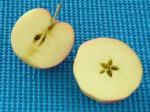poor pollination may be the reason!! Each seed that does not get pollinated limits the development of the apple in size, shape and sugar content. Oftentimes the difference between fancy fruit apples which bring top dollar, and the cheap bag apples is three or four seeds.
Seed counts are an important management tool for apple growers to evaluate success of pollination. Some apple varieties are difficult to pollinate. Red Delicious is famous for being hard to pollinate, but seed counts on Empire suggest that this apple’s sizing problems may well be due to need for more effective pollination, like it’s Delicious parent. Each block and variety should be evaluated by seed counts made at harvest time, with records kept and compared to placement, quantity of hives, hive strength, etc, to aid in decisions for the following season’s pollination management.
It suprises me how many growers do not know this simple and basic tool for pollination evaluation. We may also perpetuate false ideas by referring to apples as being “set,” when we really should talk about seeds being set. -As if one bee could visit a blossom and “set” a quality apple! It requires careful attention to both pollinizers and pollinators, with multiple visits by the bee in each blossom, to make the apples that make the money.

Leave a comment